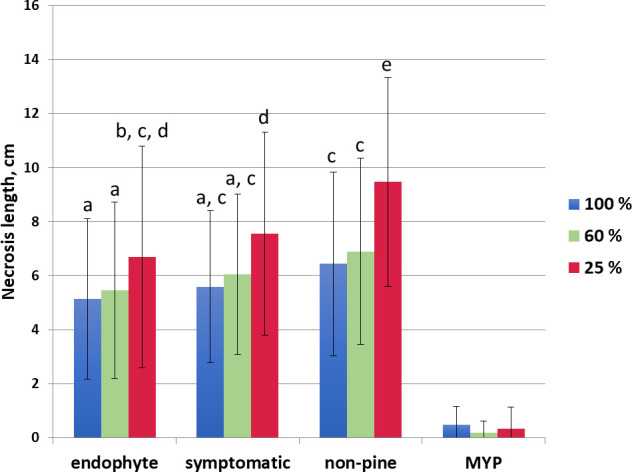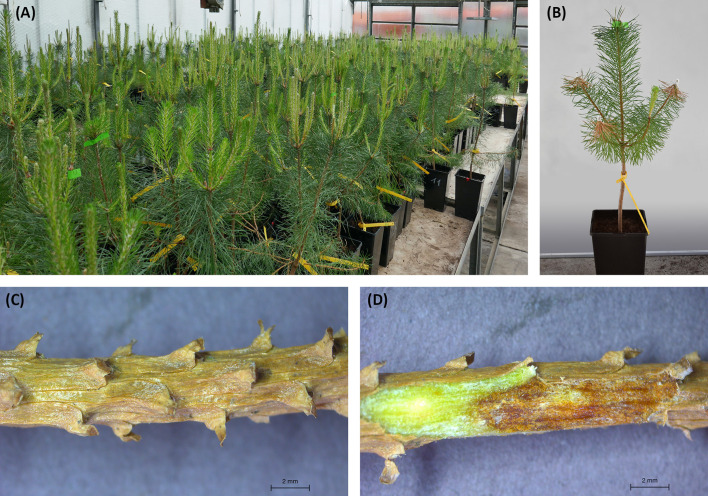Diplodia tip枯萎病病原体的毒力通过宿主切换而增强。
IF 2.1
Q3 MYCOLOGY
Frontiers in fungal biology
Pub Date : 2022-07-28
eCollection Date: 2022-01-01
DOI:10.3389/ffunb.2022.939007
引用次数: 3
摘要
干旱加剧,再加上新出现的病原体,对森林健康的威胁越来越大。这可归因于森林病理系统的不可预测行为,在持续干旱胁迫条件下,森林病理系统可能有利于真菌病原体而不是宿主。智齿Diplodia sapinea(lect Sphaeropsis sapinea)是樟子松(Pinus sylvestris)在一定环境条件下引起顶端Diplodia枯萎病(针叶树枯萎病)的最严重病原体之一。最近,这种真菌也从非针叶树宿主中分离出来,这表明它的宿主范围比以前已知的更广。在这项研究中,我们比较了不同水平的水可利用性对作为内生菌分离的D.sapinea菌株(从无症状的苏格兰松中分离的8个菌株)和病原体(从有症状的苏格兰松中分离的5个菌株)以及从有症状非松宿主中分离的五个菌株引起的坏死长度的影响。对于所有菌株,水分有效性的降低增加了苏格兰松枝条的坏死长度。在所有水分条件下,来自非松树寄主的分离株引起的反应最为严重。研究结果表明,干旱等气候变化的影响可能会导致苏格兰松树为主的森林中的D.sapinea受损,并增加受影响树木的死亡率。此外,由进行宿主转换的菌株引起的苏格兰松的坏死程度更高,这与未来的情况有关,从而增加了来自未知来源的苏格兰松感染压力。本文章由计算机程序翻译,如有差异,请以英文原文为准。



Diplodia tip blight pathogen's virulence empowered through host switch.
Increased drought combined with emerging pathogens poses an increased threat to forest health. This is attributable to the unpredictable behaviour of forest pathosystems, which can favour fungal pathogens over the host under persistent drought stress conditions. Diplodia sapinea (≡ Sphaeropsis sapinea) is one of the most severe pathogens in Scots pine (Pinus sylvestris) causing Diplodia tip blight (conifer blight) under certain environmental conditions. Recently, the fungus has also been isolated from non-conifer hosts, indicating that it has a broader host range than previously known. In this study we compared the impact of different levels of water availability on necrosis length caused by D. sapinea strains isolated as endophytes (eight strains isolated from asymptomatic Scots pine) and pathogens (five strains isolated from symptomatic Scots pine) and five strains isolated from symptomatic non-pine hosts. For all strains the decreased water availability increased the necrosis length in Scots pine shoots. The isolates from non-pine hosts caused the most severe reactions under all water availabilities. The results of the study indicate the likelihood that effects of climatic changes such as drought will drive D. sapinea damage in Scots pine-dominated forests and increase mortality rates in affected trees. Further, the higher necrosis in the Scots pines caused by strains that had performed a host switch are concerning with regard to future scenarios thus increasing infection pressure on Scots pine from unknown sources.
求助全文
通过发布文献求助,成功后即可免费获取论文全文。
去求助

 求助内容:
求助内容: 应助结果提醒方式:
应助结果提醒方式:


